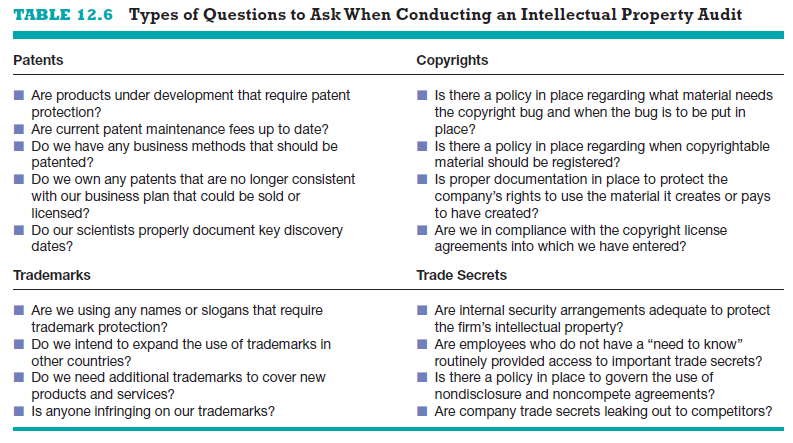The first step a firm should take to protect its intellectual property is to complete an intellectual property audit. This is recommended for all firms, regardless of size, from start-ups to mature companies. An intellectual property audit is conducted to determine the intellectual property a company owns.
The following sections describe the reasons for conducting an intellectual property audit and the basic steps in the audit process. Some firms hire attor- neys to conduct the audit, whereas others conduct the audit on their own. Once an audit is completed, a company can determine the appropriate measures it needs to take to protect the intellectual property that it owns and that is worth the effort and expense of protecting.
1. Why conduct an intellectual property Audit?
There are two primary reasons for conducting an intellectual property audit. First, it is prudent for a company to periodically determine whether its intel- lectual property is being properly protected. As suggested by the contents of Table 12.6, intellectual property resides in every department in a firm, and it is common for firms to simply overlook intellectual property that is eligible for protection.
The second reason for a company to conduct an intellectual property audit is to remain prepared to justify its value in the event of a merger or acquisi- tion. Larger companies purchase many small, entrepreneurial firms primarily because the larger company wants the small firm’s intellectual property. When a larger company approaches, the smaller firm should be ready and able to justify its valuation.
2. The process of conducting an intellectual property Audit
The first step in conducting an intellectual property audit is to develop an in- ventory of a firm’s existing intellectual property. The inventory should include the firm’s present registrations of patents, trademarks, and copyrights. Also included should be any agreements or licenses allowing the company to use someone else’s intellectual property rights or allowing someone else to use the focal company’s intellectual property.

The second step is to identify works in progress to ensure that they are being documented in a systematic, orderly manner. This is particularly im- portant in research and development. As mentioned earlier, if two inventors independently develop essentially the same invention, the right to apply for the patent belongs to the person who invented the product first. Properly dated and witnessed invention logbooks and other documents help prove the date an invention was made.
The third step of the audit is to specify the firm’s key trade secrets and describe how they are being protected. Putting this information in writing helps minimize the chance that if a trade secret is lost, someone can claim that it wasn’t really a trade secret because the owner took no specific steps to protect it.
Source: Barringer Bruce R, Ireland R Duane (2015), Entrepreneurship: successfully launching new ventures, Pearson; 5th edition.

Regards for all your efforts that you have put in this. very interesting information.
As I website possessor I believe the articles here is real excellent, thanks for your efforts.